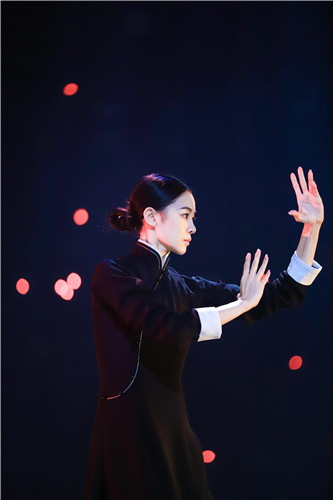 |
|
Hua Xiaoyi presents a piece, which incorporates martial arts poses into classical dance, in the TV show Dance Smash. [Photo provided to China Daily] |
Although she's an internationally acclaimed ballet dancer, Tan says the program is proving to be a novel experience for her, with its high-intensity recording schedules and limited time for choreography and rehearsals.
Tan says the first season of the program brought dancers and the audience close, and introduced dance styles to the general public. The program features a wide range of styles, including contemporary dance, Latin and hip-hop.
Tan says by participating in the second season, she wants to present high-quality works on TV, allowing a wider audience to love ballet.
"Under the current circumstances where live performances are rare, how to bring a better viewing experience to the audience with technology and other methods is a subject worth exploring," Tan says.
Expressing a similar yearning for the stage and featuring a kindred female power, award-winning dancer Hua Xiaoyi presented a piece of Chinese classical dance, Everlasting Longing, with the show's judges complimenting her exquisite mien and elegant yet expressive mannerisms.
Hua says on the program that it has been two years and nine months since she last performed onstage, during which time she had a baby. While she kept on practicing in that period, each time she went to watch a show, she would leave fearing she might be recognized by the public and suspected that she would never dance again.
"I'm here, back on the stage-the round stage which in my mind is the starting point and the original inspiration. On this stage, I want to bloom even more beautifully, more distinctively," Hua says.
The second dance Hua performed during the show, See Yourself, was a dramatic departure from the initial image she formed. A tribute to the 2013 film The Grandmaster, the performance sees her dressed in a traditional black robe and incorporating martial arts poses into classical dance.
"These two pieces are a new way of expressing myself after being immersed in classical culture. The former represents the spirit and culture of the Tang Dynasty (618-907) that attracts me, a state of civilization with supreme beauty and prosperity," Hua tells China Daily.
"The latter is my understanding of the martial arts practitioners... I think ultimately human beings are combating time and themselves, not somebody else."
Her choice of bringing performances with different styles is made to demonstrate the elasticity and control of the human body and the effects of expression.
"I find the stage of Dance Smash a diverse and inclusive one. It's very rare for so many talented dancers representing different styles to compete and cooperate on the same stage. It makes me happy to see the life experience of other performers conveyed through dance," Hua adds.